

@generalpha
Prompt
Local and global approaches in mathematics and machine learning are both universal approximators, but they differ in the number of parameters required to represent a given function accurately. The entire system, including data, architecture, and loss function, must be considered, as they are interconnected. Data can be noisy or biased, architecture may demand excessive parameters, and the chosen loss function may not align with the desired goal. To address these challenges, practitioners should
doubles, twins, entangled fingers, Worst Quality, ugly, ugly face, watermarks, undetailed, unrealistic, double limbs, worst hands, worst body, Disfigured, double, twin, dialog, book, multiple fingers, deformed, deformity, ugliness, poorly drawn face, extra_limb, extra limbs, bad hands, wrong hands, poorly drawn hands, messy drawing, cropped head, bad anatomy, lowres, extra digit, fewer digit, worst quality, low quality, jpeg artifacts, watermark, missing fingers, cropped, poorly drawn
2 years ago
Model
SSD-1B
Guidance Scale
7
Dimensions
832 × 1248



![So, my fellow seekers of mathematical truth, let us don our mathematical finery and embrace the duality of global and local. With the modulus of continuity as our guide, we shall unravel the secrets hidden within the curves and functions. With each step, we shall uncover the delicate balance between the minute details and the sweeping vistas, all while basking in the radiance of mathematical style.[Liwa Dunes] .The interplay between the local and the global is a mathematical elegance. The loca](https://img.stablecog.com/insecure/256w/aHR0cHM6Ly9iLnN0YWJsZWNvZy5jb20vMTRmMDIzZDMtZWM2Ny00N2Q5LWIyOTctOGJkOWM4NTllOTNmLmpwZWc.webp)
![[mahematics] In the context of universal approximation, two approaches can achieve similar results but with different parameter requirements. The overall system comprises data, architecture, and a loss function, interconnected by a learning procedure. Responsibilities within the system include acknowledging noisy or biased data, addressing the need for a large number of parameters in the architecture, and overcoming the principal-agent problem in the choice of the loss function.](https://img.stablecog.com/insecure/256w/aHR0cHM6Ly9iLnN0YWJsZWNvZy5jb20vZDJmYjgwZDgtMTQxZC00MmZiLTkwZTktODZmNWRkMzMyYjI2LmpwZWc.webp)

![[mahematics] In the context of universal approximation, two approaches can achieve similar results but with different parameter requirements. The overall system comprises data, architecture, and a loss function, interconnected by a learning procedure. Responsibilities within the system include acknowledging noisy or biased data, addressing the need for a large number of parameters in the architecture, and overcoming the principal-agent problem in the choice of the loss function.](https://img.stablecog.com/insecure/256w/aHR0cHM6Ly9iLnN0YWJsZWNvZy5jb20vNzE2NTdhMmYtNWI1Ny00MGM5LWFmMzgtODIxNTNjNDA5NmJiLmpwZWc.webp)




